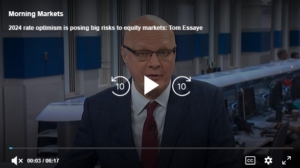Fed-Day Technical Tear Sheet (Negative Divergence from Fundamentals)
Fed-Day Technical Tear Sheet (Negative Divergence from Fundamentals): Start a free trial of The Sevens Report.
What’s in Today’s Report:
- Fed-Day Technical Tear-Sheet: Market Technicals Are Diverging Negatively from Still Optimistic Fundamentals
- Economic Takeaways: Retail Sales and Industrial Production Top Estimates
Stock futures are trading tentatively higher as investors digest mostly as-expected inflation data out of Europe overnight and look ahead to today’s Fed decision.
Economically, Eurozone CPI met estimates at 2.2% y/y in August while the Core figure was also as-expected at an unchanged 2.8% y/y last month.
Today, focus will be on the one notable economic data point due to be released: Housing Starts (1.300M) but it is unlikely to materially move markets with the Fed decision looming this afternoon.
The FOMC Announcement will hit the wires at 2:00 p.m. ET followed by Fed Chair Powell’s Press Conference at 2:30 p.m. ET. The consensus expectation is a 25 bp rate cut will be delivered but market-based policy rate expectations are pricing in a 65% chance of a 50 bp rate cut as of this morning.
Bottom line, whether the Fed delivers a 25 bp or 50 bp rate cut today is less important than the guidance provided on future cuts as the market wants to see the framework laid out for a fairly aggressive rate cutting path in the months ahead to shore up soft-landing hopes. So projections and Powell’s speech will be critical for the market reaction late in the session.
Join thousands of advisors from huge brokerage firms like Morgan Stanley, Merrill Lynch, Wells Fargo Advisors, Raymond James, and more! To start your quarterly subscription and see how The Sevens Report can help you grow your business, click here.


